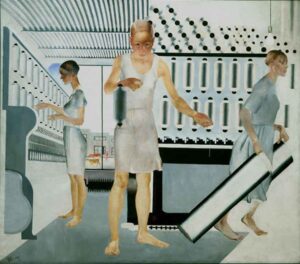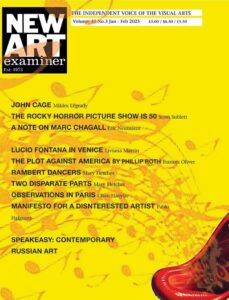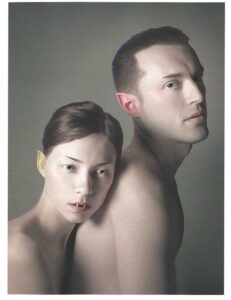
Vera Mukhina: L’operaio e la kolkotsiana, (The Worker and Kolkotsiana) (1936) Sculptural group in bronze
Liviana Martin

The quote “Women are the vine around which everything revolves” by Leo Tolstoy welcomes us at the entrance. It is the leitmotif of the exhibition, which is divided into two parts. The first concerns the way in which the woman was represented in Russia as an artistic subject, the second exhibits the artists who were part of the extraordinary development of the avant-garde currents of the 20th century.
In the section entitled The Sky, the precious icons of the Mother of Christ and some saints, which were placed in homes as well as in churches, testify to the importance that religion had for the Russian people. From heaven to earth, majestic, almost sacred, the portraits of some of the tsarinas who reigned from the end of the 17th century to 1917 stare out at us: Catherine the Great is portrayed both in official clothes and in travelling clothes, the incarnation of a very powerful woman who often travelled within her empire. The first to paint the peasants as well as royals was Alexei Venetsianov, who taught drawing to the children of serfs. His work Morning of the Lady of the House (1823) depicts, for the first time in Russian art, a scene from the daily life of masters and peasants: in a room full of light, the painter’s wife distributes the daily tasks to the young servants.
After the October Revolution, workers and peasants became the protagonists of many paintings by Kazimir Malevich, one of the greatest exponents of suprematism. His subjects are unreal, majestic and impersonal, like the saints in the icons. The proletarians become heroes and martyrs, giving birth to a new religion, the socialist state. Girls in the field and Harvest express the artist’s vision, which gives an air of universality to the stylized human figures, taken out of time and space to represent the collective portrait of an ideal society.
While in Tsarist Russia the citizens were divided into nobles, clergy, bourgeois and peasants, 1917 swept this hierarchy away, but the distinction between workers, peasants and intelligentsia remained. There are images of poets, such as the beautiful portrait of Anna Achmatova, of musicians and workers: Textile Workers by Alexander Deyneka has an almost epic tone: the war had brought poverty and hunger, and the strike of the weavers of the Filo Rosso factory for the increase in wages and food rations started the October Revolution. The women, from mothers and wives (two chilling paintings on display: a young woman forced to marry an elderly man cries desperately before the wedding; a naked young woman is examined by the groom’s family to make sure she has no imperfections), become the protagonists for the new order.
The colours of the installation change from grey to red as we enter the heart of the exhibition: the Amazons of the avant-garde, according to the definition of the Russian futurist poet Livsic, describes those artists who between 1910 and 1920, a short but dazzling period, contributed to the birth of avant-garde movements.
In Russia women had always been involved in art: they embroidered, painted toys, made pictures, but until the 19th century they had not had access to training. Only at the end of the century, with the struggle for women’s emancipation and periods of study spent abroad, were some women able to show their work in exhibitions, and these women generally belonged to the bourgeoisie. The decade 1910 to 1920 was crossed by an extraordinary wave of female creativity, before being crushed by communist power as degenerate art.

(The Worker and Kolkotsiana) (1936)
Sculptural group in bronze
Natalia Goncharova was an example of a free and revolutionary woman. She lived most of her life in Paris, absorbing the influence of futurism and cubism, but merging it with the feeling and depth
of the Russian soul. Peasant Women is a work created according to the neoprimitivist style, but the artist, painting the scenes of harvesting the fruits of the earth or shearing the sheep, inserts a deep symbolic meaning, in which the characters seem motionless, portrayed in a kind of ritual timelessness. Even in Harvest the bright colours and simple silhouettes, as in the children’s drawings, reveal a close link with Russian folk art.
Olga Rozanova, in her short life (she died at 32), was, according to Malevich, one of the original interpreters of suprematism. Initially close to the Italian futurists, she emancipated herself from both this style and cubism, to arrive at pure abstraction. Her paintings, which the artist called ‘non-objective paintings’, are full of colour, energy, and geometric shapes that are wedged into each other.
A refined and intense work is City of Night by Aleksandra Ekster, in which cubo-futurism, orphism and abstraction are combined, with bright colours and an almost musical sense of composition, enriched by a simplicity of popular taste.
Zinaida Serebrjakova belonged to a wealthy bourgeois family, which after 1917 was reduced to poverty. The artist, after a trip to France, was censored and unable to return home or see her family for a long time. Her paintings demonstrate a classicism in the poses, an exaltation of the simple life of the fields, and the joy of living. In Self-portrait the painter pulls us inside the painting as if she had been surprised at a moment of her day. Bathers and Dancers reveals the opulence of the female physical forms, the statuesque protagonists.
In 1932, the CPSU banned all styles that referred to the West, in favor of socialist realism, chosen as the official expression of Soviet art. The most striking example of the new trend is the sculpture that closes the exhibition, The Worker and the Kolkotsiana, a work by Vera Mukhina, symbol of Russia at the Paris Expo in 1937. The two figures, holding the scythe and the hammer, made of steel, faced the German pavilion represented by the Nazi eagle.
Here ends the short but glorious adventure of the extraordinary Amazons of art. Only in recent years, after the thaw in relations, has their art been rediscovered and re-evaluated by the western public.
Divine and avant-garde; Women in Russian art. Palazzo Reale, Milan, October 28, 2020 – April 5, 2021. Admission € 14
Volume 35 no 3 January – February 2021

